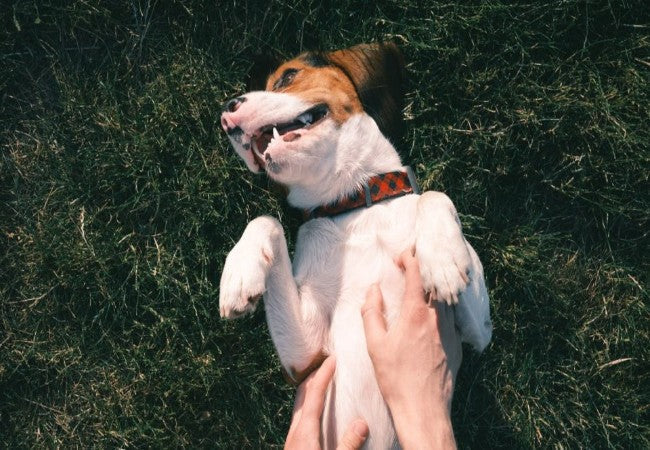Vet Approved Guide: Why Dogs Love Belly Rubs (And When They Don’t) – 2025 Edition🩺🐶

In this article
Vet Approved Guide: Why Dogs Love Belly Rubs (And When They Don’t) – 2025 Edition🩺🐶
By Dr. Duncan Houston BVSc
Belly rubs are one of the most beloved ways people bond with their dogs—but what do they really mean? As a veterinarian, I’ve seen dogs melt into a rub with blissful joy, while others stiffen or snap if their belly is touched. So, is it affection, submission, or something else? 🧠🐶
In this guide, we’ll explore the real reasons dogs roll over, what belly exposure means in different contexts, and how to safely offer rubs. You’ll also learn how Ask A Vet. 🩺🐾
🔍 Why Dogs Show Their Belly
1. 💛 Affection and Trust
When your dog flops on their back with a loose, wiggly body, it’s often a sign of comfort and vulnerability. They're saying, “I trust you.” Belly exposure is a submissive gesture that, when paired with a happy face and wagging tail, signals love. ❤️
2. 😌 It Just Feels Good
Many dogs love the feel of touch on their chest, ribs, and tummy. The skin on a dog’s belly is thinner and more sensitive—similar to our own inner arms. Rubbing can trigger pleasant nerve responses, especially in areas packed with hair follicles. 🧠👐
3. 🧘 Cooling Off
Dogs with thick coats or those in warm climates may roll belly-up to cool off. The abdomen has less fur and releases heat more easily. In this case, your dog might be inviting airflow, not affection. 🌬️
4. 🙃 Play or Submission?
Sometimes dogs roll over in play to de-escalate excitement or show deference. In these cases, rubbing can overwhelm them. Learn how to read their signals below. 🕵️
🧠 The Science Behind Belly Rub Bliss
When dogs enjoy belly rubs, their brains release:
- 🧠 Oxytocin: The “bonding hormone” released during positive touch
- 😌 Endorphins: Natural mood boosters
- 💤 Serotonin: Promotes relaxation and well-being
This is why some dogs fall asleep or sigh during belly rubs—it’s the equivalent of a human massage. 💆♂️🐶
👀 When a Belly Rub Is Not a Good Idea
🚫 Signs It’s Not an Invitation:
- 🔒 Stiff or tense posture
- 👁️ Whale eye (seeing the whites of the eyes)
- 🦴 Lip licking or yawning
- 🐕 Low growling or tail tucked
Dogs may show their bellies in fear or submission, not seeking touch. Rubbing in those moments can escalate stress or trigger defensive bites. ❌
🐾 Breeds or Personalities Less Comfortable With Belly Touch
- 🛡️ Guarding breeds (e.g., Akitas, Dobermans)
- 😨 Formerly abused or rescued dogs
- 🧠 Highly independent breeds (e.g., Basenjis)
If your dog reacts unpredictably, consult Ask A Vet for behavioral screening. 📱🩺
🧩 Training Belly Rub Tolerance (If Needed)
1. 📍 Start with Gentle Side Rubs
- Never approach from above or suddenly touch the belly
- Use calm voice and slow movements
2. 🎁 Pair with Positive Reinforcement
- Offer treats or praise when your dog relaxes during touch
3. 🎓 Use Woopf Tools to Desensitize
- Touch-training routines to create trust with handling
- Focus games to redirect nervous energy
📱 When to Consult Ask A Vet
Some belly exposure may signal pain or a medical issue—like:
- 🐾 Excessive belly licking or biting
- 🩹 Redness, bumps, or hair loss
- 📉 Sudden aversion to touch
Use Ask A Vet to get real-time advice from licensed veterinarians. 🩺
✅ Final Takeaways: Respect the Belly Language
When a dog rolls over, they may be saying “rub my tummy” or “give me space.” Learning to read the difference helps you build trust, respect boundaries, and deepen your bond. Whether they’re rub-lovers or belly-shy, every dog deserves to feel safe in your touch. 🤝🐕
Quick Recap:
- 💛 Dogs show their belly for trust, pleasure, or heat relief
- 🚫 Not all belly rolls mean “rub me”—watch for stress signs
- 🧠 Positive touch releases calming hormones
- 📱 Use Ask A Vet for guidance if unsure
Need help reading your dog’s signals? Visit AskAVet.com. 🐾📱






